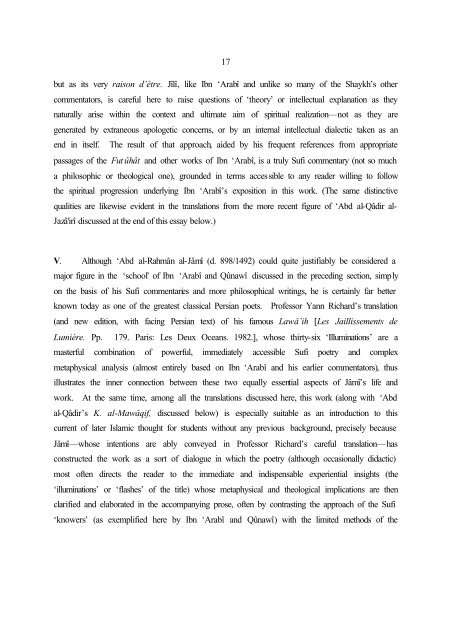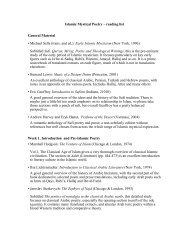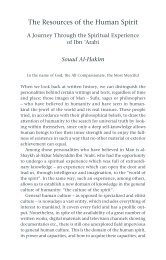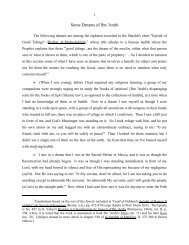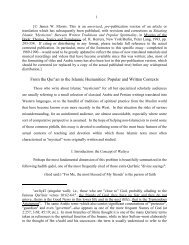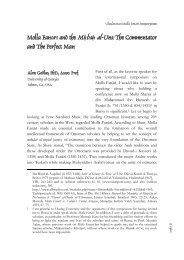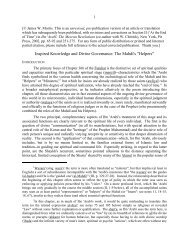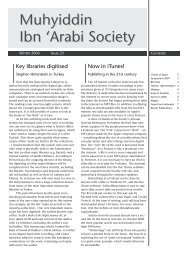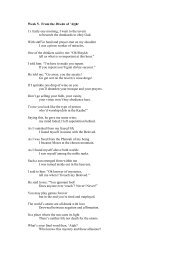16fashion to develop and express new insights and original ideas. 95 Indeed a relatively completeand appropriately annotated translation of such a work, difficult as that might be, could helptransform many widespread misconceptions concerning this whole current of later Islamicthought.In the meanwhile, readers can find an excellent, eminently readable illustration of thesedistinctive qualities of Jîlî’s work in the recent partial translation of his commentary on <strong>Ibn</strong>‘Arabî’s R. al-Anwâr [Journey to the Lord of Power. Tr. R. T. Harris. Pp. 116. New York: InnerTraditions International. 1981.]. 96 What is remarkable about that ‘commentary,’ in comparisonwith the works by authors discussed earlier in this section, is its consistent, unmistakablereference to direct experience of the realities in question, not just as a premise of the discussion,95 In Jîlî’s case, the almost universal problem, for modern students and translators of laterIslamic thought, of widespread ignorance of the distinct traditions of later kalâm and Avicennanphilosophy (already cited at nn. 55-56 and 59-60, <strong>Part</strong> II-A above) is further compounded by hisoften creative development of <strong>Ibn</strong> ‘Arabî’s own technical terminology, which also assumes aconsiderable acquaintance with the Shaykh’s writings in general, especially in his more complexmetaphysical discussions.This is not always the case with Jîlî, as indicated by two fascinating brief excerpts fromthe K. al-Insân al-Kâmil (from later chapters than those included in the Burckhardt translation),which are readily accessible in the English translation of H. Corbin’s Spiritual Body andCelestial Earth, (tr. N. Pearson, Princeton, 1977), pp. l4-63. (The first selection concerns thefavorite Sufi theme of the ‘men of al-A‘râf’ [cf. Qur’an 7:46 ff.], the second a mysticalencounter with the initiatic figure of al-Khadir/Khizr.) Without already being informed that Jîlîwas their author, it would be difficult indeed for readers to imagine that these passages are drawnfrom the same book as the earlier chapters translated by T. Burckhardt in the above-mentionedvolume.96 The excerpts drawn from Jîlî’s commentary here cover 33 pages, versus only 24 pagesfor the actual translation of <strong>Ibn</strong> ‘Arabî’s text. (Asin Palacios' earlier translation of the sameinfluential text was discussed in <strong>Part</strong> I above.) This partial English version also includes ahelpful 11-page glossary (including explanations of biographical references to earlier Sufiauthors), while the work as a whole—including the introductory material by two contemporaryJerrahi Sufi shaykhs—reflects the great esteem Jîlî long enjoyed in Ottoman (by no meansexclusively ‘Turkish’) Sufi circles, a phenomenon also indicated by the many manuscripts of hisworks found in libraries in that region (n. 93 above).Although the translations in this work are not by a scholarly specialist, any shortcomingsin that regard (e.g., technical terms not always clearly explained as such, references and allusionsnot always identified) are somewhat counterbalanced by the translator’s obvious care for theclarity and readability of her final version—a fundamental consideration that is unfortunately notalways so apparent in the available translations in this field.
17but as its very raison d’être. Jîlî, like <strong>Ibn</strong> ‘Arabî and unlike so many of the Shaykh’s othercommentators, is careful here to raise questions of ‘theory’ or intellectual explanation as theynaturally arise within the context and ultimate aim of spiritual realization—not as they aregenerated by extraneous apologetic concerns, or by an internal intellectual dialectic taken as anend in itself. The result of that approach, aided by his frequent references from appropriatepassages of the Fut ûhât and other works of <strong>Ibn</strong> ‘Arabî, is a truly Sufi commentary (not so mucha philosophic or theological one), grounded in terms accessible to any reader willing to followthe spiritual progression underlying <strong>Ibn</strong> ‘Arabî’s exposition in this work. (The same distinctivequalities are likewise evident in the translations from the more recent figure of ‘Abd al-Qâdir al-Jazâ'irî discussed at the end of this essay below.)V. Although ‘Abd al-Rahmân al-Jâmî (d. 898/1492) could quite justifiably be considered amajor figure in the ‘school’ of <strong>Ibn</strong> ‘Arabî and Qûnawî discussed in the preceding section, simplyon the basis of his Sufi commentaries and more philosophical writings, he is certainly far betterknown today as one of the greatest classical Persian poets. Professor Yann Richard’s translation(and new edition, with facing Persian text) of his famous Lawâ’ih [Les Jaillissements deLumière. Pp. 179. Paris: Les Deux Oceans. 1982.], whose thirty-six ‘Illuminations’ are amasterful combination of powerful, immediately accessible Sufi poetry and complexmetaphysical analysis (almost entirely based on <strong>Ibn</strong> ‘Arabî and his earlier commentators), thusillustrates the inner connection between these two equally essential aspects of Jâmî’s life andwork. At the same time, among all the translations discussed here, this work (along with ‘Abdal-Qâdir’s K. al-Mawâqif, discussed below) is especially suitable as an introduction to thiscurrent of later Islamic thought for students without any previous background, precisely becauseJâmî—whose intentions are ably conveyed in Professor Richard’s careful translation—hasconstructed the work as a sort of dialogue in which the poetry (although occasionally didactic)most often directs the reader to the immediate and indispensable experiential insights (the‘illuminations’ or ‘flashes’ of the title) whose metaphysical and theological implications are thenclarified and elaborated in the accompanying prose, often by contrasting the approach of the Sufi‘knowers’ (as exemplified here by <strong>Ibn</strong> ‘Arabî and Qûnawî) with the limited methods of the


